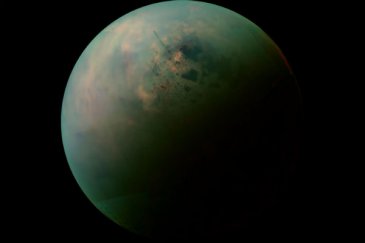Scientists have modeled a methane-based life-form that could exist without oxygen and theoretically thrive in the hostile environment of Titan, one of Saturn's icy moons.
Titan has a highly pressurised nitrogen and methane atmosphere, and is the only other planetary body in our Solar System with naturally occurring liquid on its surface. It has three methane seas near its northern pole, a feature that was confirmed after the Cassini spacecraft made a flyby in 2006.
Now, chemical engineers from Cornell University in the US say it's theoretically possible that life - in a different form than exists on Earth - could take shape inside these dreadfully cold seas.
The team has built a model of a cell membrane that doesn't need oxygen to survive or reproduce, and they say it's the "first concrete blueprint of life not as we know it".
The team's theorised cell membrane - called an azotosome, or nitrogen body - is composed of small organic nitrogen compounds, and is capable of functioning in liquid methane temperatures close to absolute zero, or minus 273 degrees Celsius.
"We're not biologists, and we're not astronomers, but we had the right tools," said molecular chemist Paulette Clancy in a statement.
"Perhaps it helped, because we didn't come in with any preconceptions about what should be in a membrane and what shouldn't. We just worked with the compounds that we knew were there and asked, 'If this was your palette, what can you make out of that?'"
On Earth, cells are protected by the phospholipid bilayer membrane. This is a strong, permeable, water-based vesicle that houses the organic matter of every cell. It is fundamental for life, and has so far directed our search for extraterrestrial life to planets that orbit their star in what's sometimes called the Goldilocks zone — a narrow band where liquid water might exist, and conditions might be similar to Earth.
But in modelling their new cell, the Cornell team has thrown out the assumption that oxygen is essential for the formation of life.
Using data from Cassini about the known substances in Titan's methane atmosphere and seas, the researchers began a process of screening for potential molecules that would be able to self-assemble into something resembling a membrane. Importantly, the resulting structure needed to be both stable and flexible, like cells on Earth, however this is incredibly difficult to achieve at cryogenic temperatures.
According to the press release, the most promising compound they found for their membrane was acrylonitrile - a colourless, poisonous, liquid organic compound, which is used in the manufacture of acrylic fibres, resins and thermoplastics. The team has published a paper describing its findings in Science Advances.
While the researchers say their work doesn't prove that life exists on Titan, and don't elaborate on what their theoretical aliens might look like, should they evolve, they say it could redirect the search for alien life.
"As our understanding of conditions that could nurture extraterrestrial life expands, so does our probability of finding it, perhaps within the liquid methane habitable zone," they write.
NASA is hoping to one day explore Titan's methane seas with futuristic submarines. Maybe they'll find something unexpected.
